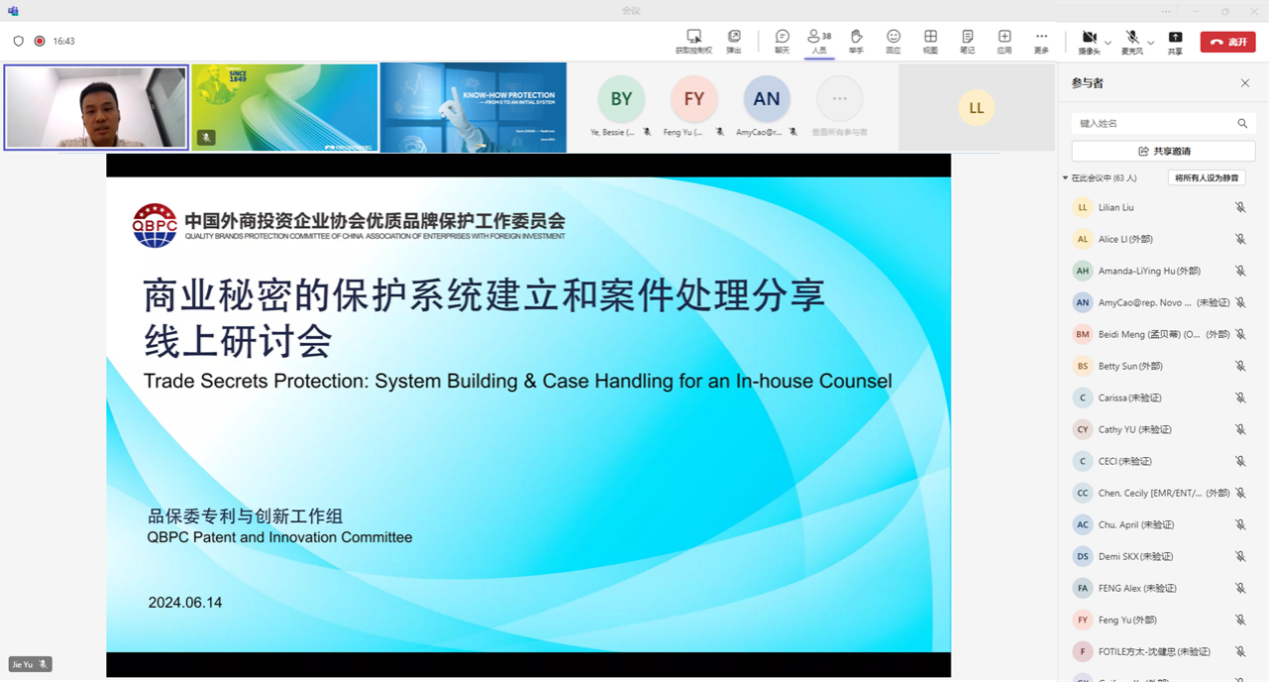On June 14, the Quality Brands Protection Committee of China Association of Enterprises with Foreign Investment (QBPC) Patent and Innovation Committee (PIC) held an online seminar on system building and case handling for trade secret protection. The seminar was hosted by Kevin Zheng, PIC Vice Chair, and more than 70 QBPC members attended. Kevin Zheng and Bessie Ye provided an in-depth and extensive explanation on how to set up a system to protect technological secrets, as well as strategies for protecting trade secrets and handling relevant cases.

First of all, Kevin emphasized that, as China's R&D capability improved, the competition in the commercial market had become more intense, and many enterprises were actively engaged in product R&D, making trade secrets protection a growing focus for enterprises. Due to China's unique R&D strength, market size, and judicial environment, many IP counsels of multinational enterprises are frequently required to take on the vital responsibility of protecting trade secrets on their own in China. Through a case study, he then demonstrated the significance of trade secret protection in enterprise development, highlighting the dire need for a robust protection system. Hence he proposed four tips: focusing on critical trade secrets, improving internal communication, choosing the right contact person, and actively contacting relevant colleagues in different departments of the company. In addition, he underlined the need to ensure broad coverage of the system once built as well as providing advice for accelerating the process while advocating for change. Finally, he re-emphasized the importance of maintaining adequate communication with colleagues at the headquarters during the project execution, as well as paying close attention to promoting the outward impact, in order to improve the overall level of trade secret protection in China.
Bessie discussed the characteristics of trade secret cases as well as the status quo of civil, criminal, and administrative protection of trade secrets. After analyzing the reasoning and approaches for evidence collection in the practice of trade secret protection and case handling, she recommended relevant strategies accordingly. Bessie also pointed out the essential aspects of investigation, considerations for rights protection, challenges in handling cases, and strategies for responding in trade secret infringement cases. Considering the difficulties in the execution of court judgement, particularly for terminating infringement, she suggested that the interpretation of the legal provisions should be based on the business scenarios when planning litigation claims. Finally, she stated that in the process of investigating and dealing with trade secret infringement cases, it was necessary to respond flexibly and dynamically according to the actual situation, gradually clarify the infringing subjects and their respective infringement behaviors and scales as the investigation and evidence collection went further, and accordingly make appropriate adjustments to the strategy. In terms of selecting methods to protect rights, the right holders should consider flexible application of different approaches such as criminal-civilian overlap, patent ownership disputes, employee non-compete labor arbitration, etc.
